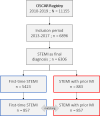Comparison of the pathways of care and life courses between first-time ST-elevation myocardial infarction (STEMI) and STEMI with prior MI: findings from the OSCAR registry
- PMID: 33154054
- PMCID: PMC7646338
- DOI: 10.1136/bmjopen-2020-038773
Comparison of the pathways of care and life courses between first-time ST-elevation myocardial infarction (STEMI) and STEMI with prior MI: findings from the OSCAR registry
Abstract
Objectives: We hypothesised that patients having experienced one coronary event in their life were susceptible to present differences in their pathways of care and within 1 year of their life courses. We aimed to compare pathways between first-time ST-elevation myocardial infarction (STEMI) and STEMI with prior myocardial infarction (MI).
Design: A retrospective observational study based on the Observatoire des Syndromes Coronariens Aigus du réseau RESCUe (OSCAR) registry collecting all suspected STEMI from 10 percutaneous coronary intervention centres in France.
Setting: All patients with STEMI from 2013 to 2017 were included (N=6306 with 5423 first-time STEMI and 883 STEMI with prior MI). We provided a matching analysis by propensity score based on cardiovascular risk factors.
Participants: We defined first-time STEMI as STEMI occurring at the inclusion date, and STEMI with prior MI as STEMI with a history of MI prior to the inclusion date.
Results: Patients with first-time STEMI and patients with STEMI with prior MI were equally treated during hospitalisation and at discharge. At 12 months, patients with first-time STEMI had a lower adherence to BASIC treatment (ie, beta-blocker, antiplatelet therapy, statin and converting enzyme inhibitor) (48.11% vs 58.58%, p=0.0167), more frequently completed the cardiac rehabilitation programme (44.33% vs 31.72%, p=0.0029), more frequently changed their lifestyle behaviours; more frequently practiced daily physical activity (48.11% vs 35.82%, p=0.0043) and more frequently stopped smoking at admission (69.39% vs 55.00%, p=0.0524). The estimated mortality was higher for patients with STEMI with prior MI at 1 month (p=0.0100), 6 months (p=0.0500) and 1 year (p=0.0600).
Conclusions: We provided an exhaustive overview of the real-life clinical practice conditions of STEMI management. The patients with STEMI with prior MI presented an optimised use of prehospital resources, which was probably due to their previous experience, and showed a better adherence to drug therapy compared with patients with first-time STEMI.
Trial registration number: Commission Nationale de l'Informatique et des Libertés (number 2 013 090 v0).
Keywords: ST-elevation myocardial infarction; recurrence; risk reduction behavior; secondary prevention.
© Author(s) (or their employer(s)) 2020. Re-use permitted under CC BY-NC. No commercial re-use. See rights and permissions. Published by BMJ.
Conflict of interest statement
Competing interests: None declared.
Figures




References
Publication types
MeSH terms
LinkOut - more resources
Full Text Sources
Medical
